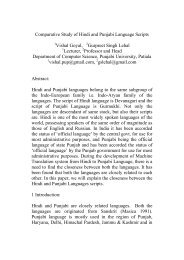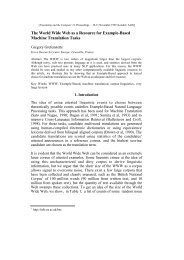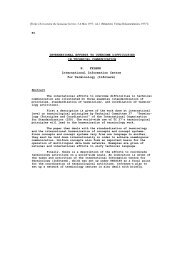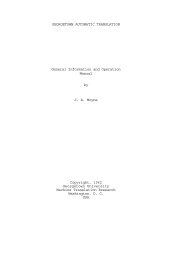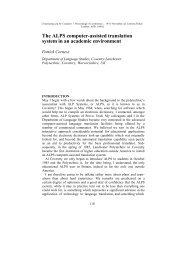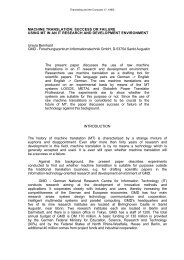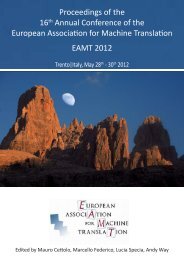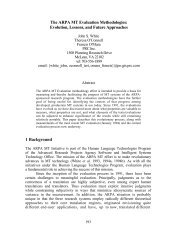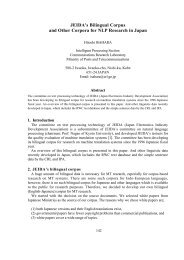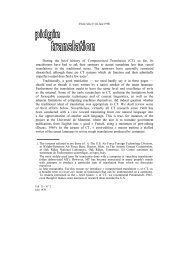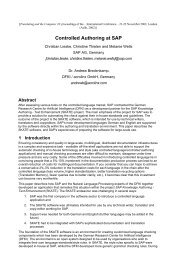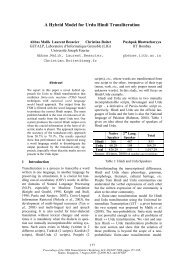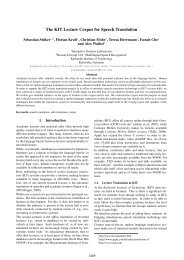Machine translation with inferred finite-state transducers
Machine translation with inferred finite-state transducers
Machine translation with inferred finite-state transducers
Create successful ePaper yourself
Turn your PDF publications into a flip-book with our unique Google optimized e-Paper software.
Computational Linguistics Volume 30, Number 2<br />
Example 2<br />
Let A be a training sample composed by the following pairs (Italian/English):<br />
Suitable alignments for these pairs are<br />
212<br />
una camera doppia # a double room<br />
una camera # a room<br />
la camera singola # the single room<br />
la camera # the room<br />
una camera doppia # a (1) double (3) room (2)<br />
una camera # a (1) room (2)<br />
la camera singola # the (1) single (3) room (2)<br />
la camera # the (1) room (2)<br />
In the first pair of this example, the English word double could be assigned to<br />
the third Italian word (doppia) and the English word room to the second Italian word<br />
(camera). This would imply a “reordering” of the words double and room, which is not<br />
appropriate in our <strong>finite</strong>-<strong>state</strong> framework.<br />
Given s, t, and a (source and target strings and associated alignment, respectively),<br />
the proposed transformation z = L1(s, t) avoids this problem as follows:<br />
zi =<br />
⎧<br />
⎨<br />
⎩<br />
| z | = | s |<br />
1 ≤ i ≤|z |<br />
(si ,tj tj+1 ...tj+l) if ∃j :a(j) =i and ∃| j ′ < j :a(j ′ ) > a(j)<br />
and for j ′′ : j ≤ j ′′ ≤ j + l,a(j ′′ ) ≤ a(j)<br />
(si , λ) otherwise<br />
Each word from t is joined <strong>with</strong> the corresponding word from s given by the alignment<br />
a if the target word order is not violated. Otherwise, the target word is joined <strong>with</strong><br />
the first source word that does not violate the target word order.<br />
The application of L1 to example 2 generates the following strings of extended<br />
symbols:<br />
(una , a) (camera , λ) (doppia , double room)<br />
(una , a) (camera , room)<br />
(la , the) (camera , λ) (singola , single room)<br />
(la , the) (camera , room)<br />
As a more complicated example, the application of this transformation to example 1<br />
generates the following string:<br />
(¿ , λ) (Cuánto , how much) (cuesta , does) (una , a) (habitación , λ)<br />
(individual , single room cost) (por , per) (semana , week) (? , ?)<br />
In this case the unaligned token ? has an associated empty target string, and the<br />
target word cost, which is aligned <strong>with</strong> the source word cuesta, is associated <strong>with</strong> the<br />
nearby source word individual. This avoids a “reordering” of the target string and<br />
entails an (apparently) lower degree of nonmonotonicity. This is achieved, however,<br />
at the expense of letting the method generalize from word associations which can be<br />
considered improper from a linguistic point of view (e.g., (cuesta, does), (individual, single



